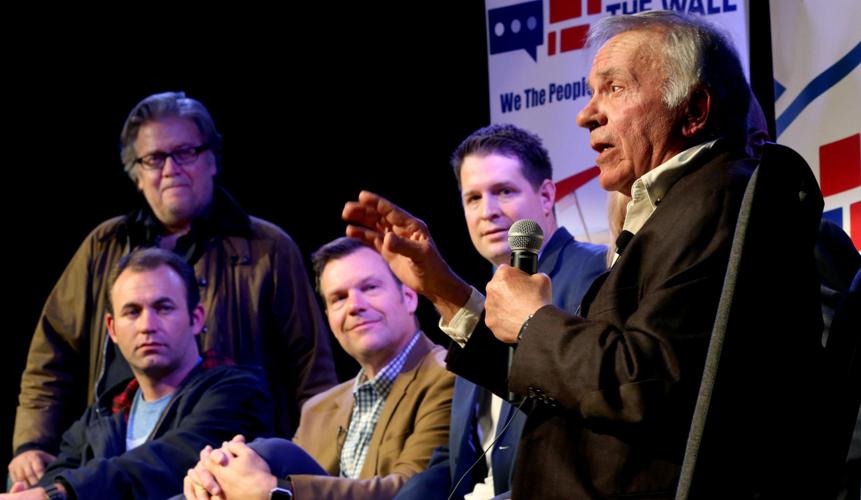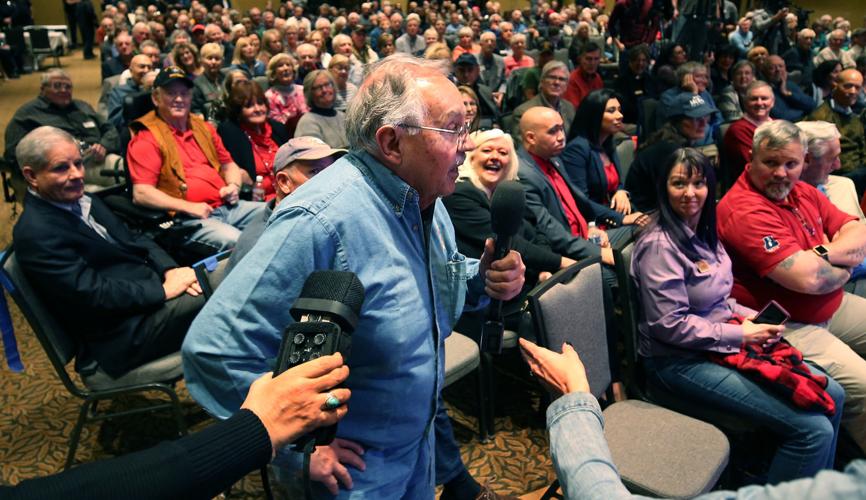As Congress and President Trump debate funding a wall on the border with Mexico, 300 ardent Trump supporters gathered Friday evening in Sahuarita to hear about plans to use private funds to build a wall.
Organizers of the We Build the Wall campaign were short on specifics, but said they could build a wall cheaper, faster and better than the federal government by using crowdfunding to pay for walls on ranches and private land, including in Arizona.
“We put together the original gangsters, the O.G.s of the MAGA movement” to help the campaign, said former Trump adviser Steve Bannon.
Bannon told the crowd of mostly retirees at the Quail Creek Country Club that they had met with Southern Arizona ranchers and are consulting with “high level” elected leaders in Arizona.
Bannon was joined by another former presidential adviser, Kris Kobach, and former Congressman Tom Tancredo, an immigration hard-liner from Colorado. Also there was the leader of the crowdfunding campaign, Brian Kolfage, an Air Force veteran who lost three limbs while serving in Iraq after attending the University of Arizona.
The campaign sprang from an online effort in December to raise $1 billion to build a wall along the southern border. The campaign was eventually canceled, but not before the group raised $20.6 million from about 350,000 people. The effort has now morphed into a formal foundation that’s raising money.
Kobach and the campaign’s “land acquisition committee” spent all day Thursday meeting with “eight to 10 ranchers,” mostly in Cochise County, Bannon said in an interview after the event.
“They were all interested in doing something on their land,” Bannon said. None of the ranchers wanted to give their name at this time, he said.
The group’s wall eventually would “link” to the wall the government builds, “almost like a Lego locks in,” Kolfage said.
“All I want is to see this wall built,” said Wayne Scheel, an 82-year-old owner of a nudist resort in Marana, who was recognized by the speakers for donating $10,000 to the project.
Ron Poedtke, 83, donated $100 to the project, saying “we’ve got to protect our sovereignty.”
Poedtke attended the event with Carole Keane, 72. Both are residents of Quail Creek who agree with building a wall, but wanted to know more about specifics of the project.
Keane questioned how the project would deal with the local governments that dot the U.S.-Mexico border and may have building regulations of their own.
“We have to get a permit to put a barbecue pit in. And they’re going to get a permit to build a wall?” she said.
Poedtke wanted to know where the money would end up if the plan to build a wall falls through, although he said he was open to learning about “options.”
“With a $200 million pot, a lot of attorneys are going to say, ‘Oh, man, I want to be a part of this,’” Poedtke said.
The panel of speakers did not broach the subject of what would happen with donations if the plan to build the wall fell through.
When asked in the interview whether there was a guarantee donors would have their money refunded if the plan failed, Bannon said, “That’s not an issue with us.”
Bannon pointed to Kolfage’s initial campaign, saying most of the donors said they would opt in to build the wall with private money after a technicality derailed the original plan to give the donations to the U.S. treasury.
He acknowledged some money likely will be spent on attorneys, as Poedtke foresaw, but “100 percent of this money is going to build the wall and the legal fight.”
Kobach promised the crowd the group could not only start building a border wall before the government even secures funding, but that the group could build it for one-half the cost.
He said not all of the group’s future efforts will be publicized, saying some actions could attract unwarranted attention from outside groups that would file lawsuits in attempts to delay construction on private land.
Kolfage said he is optimistic construction on private land could start soon.
Another purpose appeared to be courting the news media, as dozens of cameras pointed at the stage and at least one conservative news outlet live-streamed a portion of the event.
The 90-minute event was long on inspiration and applause lines for “Make America Great Again” devotees, but short on specifics about what would happen next as they continue to collect money.
A handful of Quail Creek residents protested the event with signs reading “hate has no place here” and “build bridges not walls.”
Activist Bryan Sanders, best known for being punched at a Trump rally in Tucson in 2016, briefly disrupted the event when he tried to hand Bannon a “gift” from his backpack. A man in the audience called out to “Shut him down!” and police led Sanders out of the room as he called Bannon a “racist.”
The event was organized by the Quail Creek Republican Club in cooperation with the We Build the Wall campaign.
The campaign organizers claim to have Trump’s blessing. The president has not tweeted or spoken publicly about the effort, The Associated Press reported.
It’s unclear how many miles of wall the group will build, but Kobach said even if they only build 10 miles, that is more than the administration has been able to build while dealing with “shackles from Congress.”
The bulk of the privately owned land along the U.S.-Mexico border is in Texas. Building a privately funded wall along much of Arizona’s border with Mexico would be complicated.
The federal government owns most of the land from Nogales west to the Yuma area, including a military bombing range and wildlife areas. Most of the rest of the land is part of the Tohono O’odham Nation.
Ranchers who lease land from the National Forest Service to graze cattle are not legally allowed to build a wall without approval from the Forest Service, said agency spokeswoman Heidi Schewel.
Before any project can begin on Forest Service land, an environmental analysis must be done under the Environmental Policy Act, Schewel said.
But east of Nogales, relatively little land along the border is owned by the federal government, except for stretches of the Coronado National Forest.
The Ladd family’s ranch shares 10 miles with the border in Cochise County.
Howard Buffett, son of billionaire Warren Buffett, owns seven miles of land along the border in Cochise County and actively participates in local border enforcement, as the Phoenix New Times detailed in a series of stories last month.
The vast majority of the land within 60 feet of the international boundary in Arizona, as well as in California and New Mexico, is owned by the federal government.
The land was set aside for federal anti-smuggling efforts in a 1907 proclamation by President Theodore Roosevelt, although exceptions were made for some pre-existing land claims.
The 372-mile-long border in Arizona includes about 120 miles of pedestrian fencing and 180 miles of vehicle barriers.





